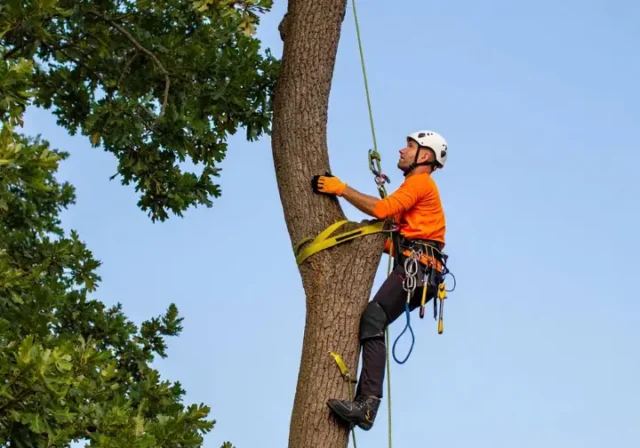In this article
Navigating the world of specialized climbing gear often feels like mapping a complex ascent. Tree climbing spikes, a tool frequently seen in professional tree care, require specific knowledge to use safely and appropriately. This guide explores what these tools are, when their use is justified, the potential harm they can cause, different types available, and the critical safety protocols surrounding them. Let’s ascend into the details.
Understanding this equipment is the first step towards responsible and skilled work aloft.
What Are Tree Climbing Spikes?
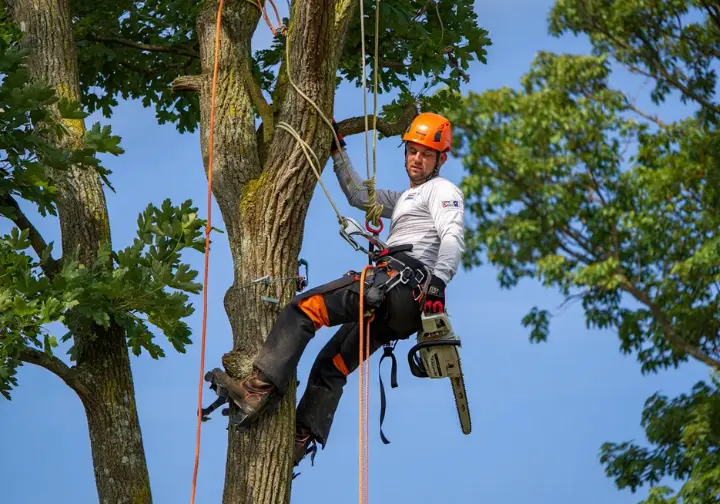
This section clarifies the terminology, components, and basic function of tree climbing spikes, setting the foundation for understanding their specific role in professional climbing scenarios.
Defining Spurs and Gaffs
You’ll hear terms like “spikes,” “spurs,” and “gaffs” used, sometimes interchangeably. Technically, the gaff is the sharp point penetrating the wood. The entire device worn on the leg – shank, stirrup, pads, straps, and gaff – is the spur or climber. Knowing this helps when discussing parts and functions.
This gear is specifically for ascending wooden structures like trees slated for removal or utility poles, where wood damage isn’t a concern. They aren’t meant for accessing trees being preserved due to the harm they inflict. Their design serves this distinct professional purpose.
While basic climbing aids have ancient roots, modern spurs developed significantly in the 19th century alongside industries needing vertical wood access. Today’s spurs use advanced materials like steel, aluminum, and carbon fiber for better performance, reflecting their evolution as specialized tools.
The naming confusion might stem from history or regional differences. Using the correct terms – spur/climber for the device, gaff for the point – aids clear communication about features, upkeep, and safe use.
Their core function is providing a secure foothold on vertical wood by penetrating it with the gaff. This mechanism is vital for tree removal and utility pole access, setting spurs apart from non-damaging methods used in tree preservation.
Anatomy of a Climbing Spur
The main structure is the shank, running vertically along the leg, often adjustable and made from steel, aluminum, or carbon fiber. Attached is the gaff, the sharp, usually replaceable steel point providing grip; its length and angle vary (tree vs. pole gaffs). The stirrup at the base supports the boot.
Comfort and security come from pads (cushioning the shin/calf) and straps (securing the spur). Pads vary from L-pads to cushion wraps or molded cuffs. Straps use leather, nylon, Velcro, or quick-connect buckles. These parts reduce fatigue and bolster safety during long climbs.
Gaffs must meet minimum length standards (e.g., typically 1.25″ pole, 2.0″ tree per OSHA) for safety. Replaceable gaffs allow upkeep and switching types. Regular checks of all parts are vital for safe operation. You can find detailed inspection guidelines in resources like the OSHA standard 1910.269, Appendix F.
Shank designs might feature contours or offsets, improving fit or optimizing gaff angle relative to the surface. These ergonomic details enhance stability and lessen strain, showing the tool’s specialized nature for professional work.
The stirrup design affects foot support, often featuring a wide platform near the boot’s arch heel. Correct boot placement and tight lower straps are needed to transfer force well and maintain control.
Pad systems range widely, impacting comfort, support, weight, and cost. Users select based on personal preference and work duration, from basic leather L-pads to thick cushion wraps.
Strap systems also vary, from traditional buckles to modern Velcro or quick-connects like Cobra buckles. Choices affect ease of use, security, adjustability, and debris resistance, with pros often picking based on speed and reliability.
Mechanics of Ascending Trees
Climbing with spurs means driving one gaff into the wood at a steady angle, stepping up, then driving the other gaff higher – essentially “walking” up the trunk. The correct angle is vital to prevent slipping or “gaffing out,” a serious fall risk. It’s a skill requiring practice. Many climbers find maintaining a consistent rhythm helps conserve energy.
For stability, climbers using spurs almost always use a work positioning lanyard (flipline) around the tree or pole, attached to their climbing harness. This allows leaning back securely, maintaining balance, and freeing hands for work. This secondary connection is a safety standard requirement.
This combination of spurred feet and lanyard support creates the stable platform needed for tasks like making cuts during removals or utility pole maintenance. It allows efficient, safe work at height in specific, often difficult, situations. Technique and proper equipment are paramount.
Effective technique involves more than just placing gaffs; it includes using body positioning and leg movements to keep balance and reduce strain. Experienced climbers develop a smooth rhythm, ensuring secure gaff placement with each step. Quality training focuses on this technique alongside safety.
Understanding how gaff type interacts with bark is also necessary. Shorter pole gaffs might need a precise angle on thick bark. Longer tree gaffs need careful placement on thin bark to avoid over-penetration. This shows the link between equipment choice and technique. A common mistake is assuming longer is always better, which can lead to awkward footing.
Proper Use vs. Tree Damage
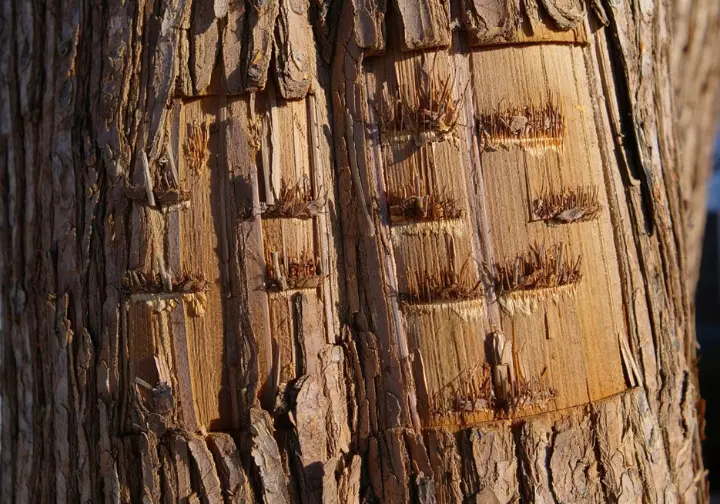
It’s absolutely vital to understand when using climbing spikes is acceptable and when it causes unacceptable harm. This distinction is central to professional arboriculture and responsible tree care.
Appropriate Use Cases
The main accepted professional use for tree climbing spikes is ascending trees marked for removal. Here, the wounds caused by gaffs don’t matter because the tree’s long-term health is irrelevant. Spikes offer an efficient way for climbers to access the trunk for dismantling.
Climbing wooden utility poles is another standard application, often using shorter “pole gaffs.” Since poles aren’t living, penetration damage doesn’t affect biological health, and spikes provide needed grip on dense wood. This is common practice for line workers.
In both removals and utility work, the stability from spikes (used correctly with a lanyard) is crucial for worker safety and efficiency. These jobs often involve heavy tools like chainsaws and demand a secure platform high off the ground.
Very rare exceptions might exist for using spikes on live trees, such as emergency aerial rescues or accessing trees near extreme electrical hazards where other methods are deemed unsafe. These are dictated by immediate safety concerns, not routine practice.
The argument for using spikes due to lack of other access (like very high first branches) is increasingly challenged by modern spikeless climbing advancements. Skilled arborists using throwlines and launchers can often access high points without damaging spikes, making spikeless methods the standard for live trees.
Why Spikes Damage Trees
Climbing spikes cause serious harm by puncturing a tree’s protective bark and the vital cambium layer beneath. The cambium is essential for growth and nutrient transport; damaging it disrupts these functions and kills tissue around each wound. This is a primary reason they are unsuitable for pruning live trees.
Each spike hole acts as an entry point for pathogens like fungi, bacteria, and wood-boring insects. These wounds bypass the tree’s natural defenses, increasing susceptibility to disease and decay, potentially weakening the tree over time. Have you ever seen the long-term effects of extensive spike damage on a mature tree?
Trees respond to wounds by compartmentalizing or sealing them off, not healing like animals do. Numerous spike wounds from pruning can overwhelm this process, leading to ineffective sealing and large dead zones on the trunk. Oozing sap after spiking clearly indicates cambium damage and stress.
Using spikes on a diseased tree can also spread pathogens to healthy trees if the spikes aren’t sanitized between uses. This adds another risk to using spikes on multiple live trees, further supporting spikeless techniques for preservation work.
Beyond biological harm, spike wounds leave permanent, unattractive marks and streaks on the bark. This aesthetic damage reduces a tree’s value, especially in landscapes where appearance matters to property owners.
Industry Standards Against Spiking
Arboricultural best practices and standards strongly advise against using climbing spikes on live trees for pruning. ANSI A300 (Part 1: Pruning) standards explicitly state spurs shall not be used for pruning, with very limited exceptions, focusing on tree health.
The Tree Care Industry Association (TCIA) actively promotes spikeless climbing for pruning live trees, emphasizing that using spikes for this purpose is unprofessional and harmful. They educate arborists and the public on proper methods. Selecting the right tree climbing gear is part of this professional approach.
While ANSI Z133 focuses on operational safety, professionals are expected to follow its principles alongside A300 best practices. Preserving tree health (A300) is integral to safe and responsible operations, meaning spiked pruning is avoided.
Hiring qualified arborists often means checking their adherence to these standards. Homeowners should ask about climbing methods and insist on spikeless techniques for pruning live trees. Resources like the Colorado State Forest Service guide can help in selecting the right professional.
Recreational tree climbing groups also strongly advocate against spikes. Their goal is enjoyment without harm, relying on ropes, harnesses, and friction savers, completely avoiding trunk damage as outlined by organizations like The Bioreserve.
Types of Climbing Spikes
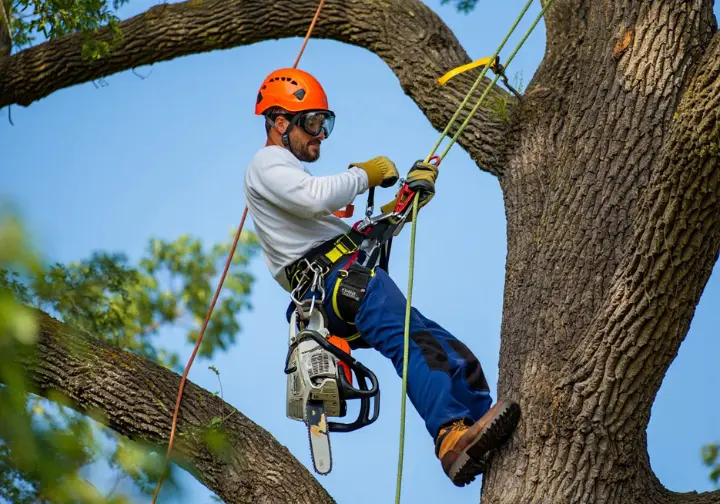
Choosing the right climbing spikes involves considering materials and gaff geometry. Each combination offers different characteristics affecting weight, durability, comfort, and cost.
Comparing Spur Materials
Steel climbers are the traditional choice, known for maximum durability and rigidity at the lowest price. They handle rugged use well but are the heaviest, potentially causing fatigue during long climbs. Brands like Buckingham and Klein offer reliable steel models.
Aluminum spurs offer a significant weight reduction compared to steel while maintaining good strength. They are a popular choice for professionals seeking a balance between performance and cost, representing a common standard in modern arboriculture. Distel, Climb Right, and Notch are key players here.
Carbon Fiber is the lightest and often most rigid option, greatly reducing climber fatigue on extended jobs. However, they carry the highest price tag and might be more vulnerable to damage from sharp impacts compared to metal spurs. Notch and Distel produce leading carbon fiber models.
Titanium climbers provide an excellent strength-to-weight ratio, usually lighter than steel but sometimes heavier than aluminum or carbon fiber, and known for durability. Buckingham has offered titanium models, typically at a premium price, as another lightweight, high-strength alternative. What’s your preferred spur material, and why does it suit your work?
The material choice directly impacts the user’s experience, presenting a trade-off between budget, desired weight savings, and perceived toughness. Professionals carefully weigh these factors based on work duration, physical demands, and available funds.
Pole Gaffs vs Tree Gaffs
Pole gaffs are shorter (around 1.25-1.75 inches) with a more acute angle. They’re designed for dense utility pole wood or thin-barked hardwoods. Some climbers prefer the stability from keeping feet closer to the structure, but they risk slipping (“gaffing out”) on thick or soft bark.
Tree gaffs are longer (around 2.0-2.75+ inches) and less acutely angled. They aim to penetrate thicker bark (like pines) to reach solid wood. While offering deeper penetration, some feel they position feet further out, potentially affecting stability if technique isn’t perfect.
The choice between pole and tree gaffs often boils down to personal preference, climbing style, and the main type of work. Many climbers use pole gaffs successfully for tree work, while others prefer tree gaffs for thick bark, stressing that proper technique is vital regardless. A common error is using pole gaffs on thick, spongy bark where they fail to reach solid wood, leading to dangerous slips.
Bark thickness and type are critical factors. Using pole gaffs on trees with thick, soft bark significantly increases the risk of the gaff not reaching secure wood. Conversely, very long tree gaffs might penetrate too deeply or awkwardly on thin-barked trees.
Some manufacturers offer “hybrid” gaffs with intermediate lengths and angles, aiming for versatility across different surfaces. These try to offer a compromise for climbers facing varied conditions frequently.
Safety regulations specify minimum gaff lengths (often 1.25″ pole, 2.0″ tree) to ensure adequate penetration. Regardless of type, gaffs must be kept above these minimums through sharpening and timely replacement.
Maintaining and Replacing Gaffs
Gaffs wear down with use and sharpening, needing regular inspection and upkeep for safety. Most modern professional spurs have replaceable gaffs, usually attached with screws or bolts. This allows users to easily swap worn or damaged gaffs, extending the main climber body’s life.
Some older or budget models might have fixed gaffs permanently attached. Once these wear below safe limits or get damaged, the entire climber usually needs replacement, making replaceable gaff systems more economical long-term. Visiting specialized suppliers like tree climbing stores can help find replacement parts.
Routine sharpening is vital to maintain the correct profile for safe wood penetration. Use appropriate tools (files, hones) and often a specialized gaff gauge to ensure correct angles and minimum lengths are maintained per manufacturer and safety specs.
Gaff gauges are essential for checking length, thickness, width, and tip profile against standards. Gaffs worn shorter than specified minimums must be replaced immediately to prevent potential failure during a climb.
For replaceable gaffs, periodically check the tightness of attachment hardware (screws/bolts). Loose gaffs can cause instability or failure while climbing, posing a severe safety hazard.
Safety and Training Essentials
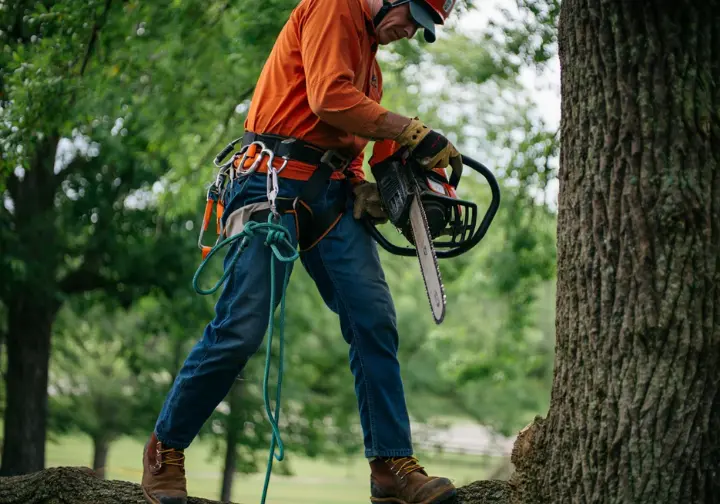
Using tree climbing spikes safely requires strict adherence to regulations, thorough training, and the use of appropriate associated Personal Protective Equipment (PPE). Safety isn’t just about the spikes themselves, but the entire system and the climber’s knowledge.
ANSI Safety Standards
ANSI Z133 is the key safety standard for US arboricultural operations, covering procedures, equipment, and hazards. It mandates climbers be secured always, requires spurs meet standards, and necessitates suitable, inspected gaffs for the tree being climbed.
ANSI A300 standards focus on tree care best practices, with Part 1 (Pruning) explicitly advising against spike use for pruning live trees due to damage. Adhering to both Z133 (safety) and A300 (tree health) defines professional conduct.
Professional arborists are expected to follow both ANSI Z133 for safety protocols and ANSI A300 for horticultural best practices. This combined approach reinforces the industry consensus against using spikes for pruning live trees intended for preservation.
These standards emphasize proper equipment selection, regular inspection, and appropriate use based on the task (removal vs. pruning). They form the foundation for training programs and professional certifications in the tree care industry.
Understanding and applying these standards is vital for worker safety, liability, and professional reputation. Compliance shows a commitment to safe work practices and responsible tree care, as outlined by resources like the ISA Store where these standards can be acquired.
OSHA Regulations Overview
OSHA sets legally enforceable workplace safety standards in the US, including tree care. Employers must comply with relevant regulations, often in 29 CFR 1910, covering electrical hazards (1910.269) and general PPE/tool safety. An overview can be found on the OSHA Tree Care Standards page.
OSHA standard 1910.269, Appendix F, gives detailed inspection guidelines for work-positioning equipment, including spurs. It specifies minimum gaff lengths, damage checks (cracks, looseness), and mandates inspection of straps/buckles, highlighting the regulatory importance of maintenance.
Employers are required by OSHA (1910.132) to provide necessary PPE at no cost. OSHA interpretations confirm this includes personal climbing equipment like spurs when needed for compliance or job tasks.
OSHA mandates comprehensive worker training on hazard recognition (falls, electrical), safe climbing techniques (including spur use), equipment inspection, fall protection, and emergency procedures. Employers are responsible for ensuring adequate training.
Compliance with OSHA regulations is mandatory for employers. Failure to comply can lead to significant penalties, and adherence is fundamental to maintaining a safe work environment for climbers using spikes.
Training and Certification Needs
Due to the risks, formal training is essential before using tree climbing spikes. Professional programs cover safety standards (ANSI Z133), hazard assessment, equipment inspection, climbing techniques (spurred and spikeless), work positioning, rigging, and vital aerial rescue procedures. Just like needing specific physical training for mountaineering, specialized skills are required here.
Industry certifications, like the ISA Certified Tree Worker Climber Specialist / Certified Tree Climber or the TCIA Tree Care Academy Climber Specialist, validate a climber’s knowledge and skills against standards. These often require experience and proof of training in safety essentials like First Aid/CPR and aerial rescue.
Eligibility for professional certifications typically involves passing written and practical exams demonstrating proficiency in safe climbing and arboricultural practices. This ensures certified individuals have the necessary competence for complex tree work. You can find details in resources like the ISA Certified Tree Climber Program Guide.
Reputable training, like that sometimes offered via the USDA Forest Service, emphasizes not just how to use equipment like spikes, but when it’s appropriate, reinforcing best practices regarding spikeless climbing for live tree preservation. This ethical component is vital.
Continuous education and refresher training are important for maintaining skills and staying updated on evolving standards, techniques, and equipment. Safety is an ongoing commitment requiring regular practice and knowledge updates.
Essential Associated PPE
Climbing spurs are part of a system; safe use requires additional Personal Protective Equipment (PPE). This includes a properly fitting arborist climbing harness (saddle) meeting relevant standards (e.g., ASTM F887). Understanding how long a climbing harness lasts and performing regular inspections is crucial.
A work positioning lanyard (flipline) is essential with spurs for stability, allowing the climber to lean back securely. Often, a secondary climbing line (using appropriate ropes for trees) and friction control device provide backup safety or descent capability.
Head protection (an approved climbing helmet) and eye protection are mandatory PPE to guard against falling debris and impacts. Work gloves enhance grip and protect hands.
Sturdy work boots, preferably climbing-specific ones with rigid shanks, provide necessary foot support and comfort when standing on spur stirrups. Standard boots might work, but specialized boots enhance performance.
Depending on the task, additional PPE like chainsaw protective legwear (chaps) may be required if cutting aloft. A full hazard assessment dictates the complete required PPE ensemble, similar to needing specific gear for mountain climbing based on conditions.
Choosing the Right Spikes
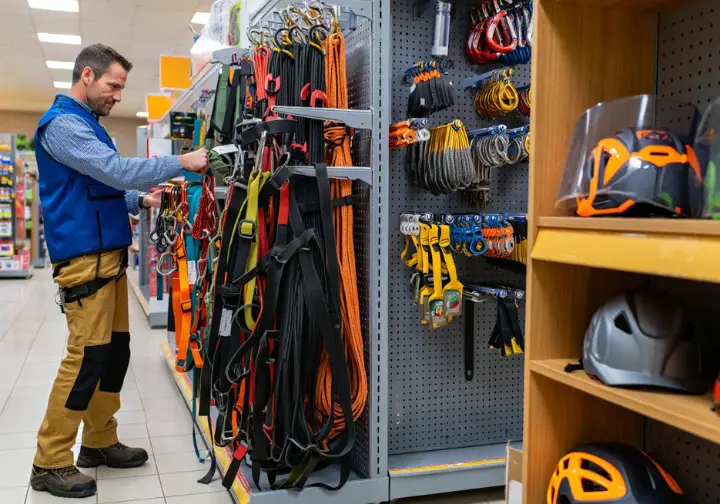
Selecting the appropriate climbing spikes depends heavily on the primary type of work, budget, and personal preferences regarding weight and comfort. Here are a few notable options reviewed:
Buckingham Steel Tree Climbers | Industry standard durability for demanding removal work
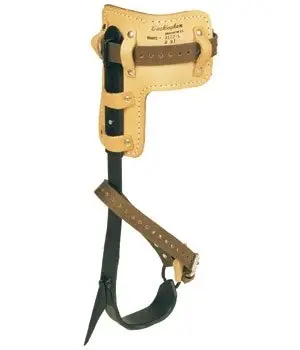
These climbers are a workhorse in the tree care industry, known for their rugged steel construction. They feature adjustable sleeves, replaceable 2-3/4″ tree gaffs designed for deep bark penetration, and comfortable leather L-pads once broken in. The contoured shanks help reduce ankle pressure during long climbs, making them suitable for demanding removal jobs where durability is paramount.
While heavier than aluminum or carbon fiber options, their steel build offers exceptional longevity and resistance to wear. The offset stirrup design aids balance, and the 350 lb rating ensures they can handle professional workloads. They represent a solid investment for arborists prioritizing toughness and reliability over minimizing weight.
Proper maintenance, including regular gaff sharpening and strap inspection, is key to maximizing their lifespan and ensuring safety. They offer a professional-grade solution at a competitive price point within the steel climber category, backed by Buckingham’s reputation.
PROS
- Highly durable steel construction
- Comfortable pads and contoured shanks (after break-in)
- Secure grip with 2-3/4″ replaceable tree gaffs
- Adjustable fit for various leg sizes
- Rated to 350 lbs for heavy-duty use
CONS
- Heavier than aluminum or carbon fiber models
- Requires break-in period for pads
- Gaffs need regular sharpening
- Nylon straps may loosen over time
- Higher initial cost than budget spikes
Klein Steel Tree Climbers | Reliable and durable steel option favored for toughness
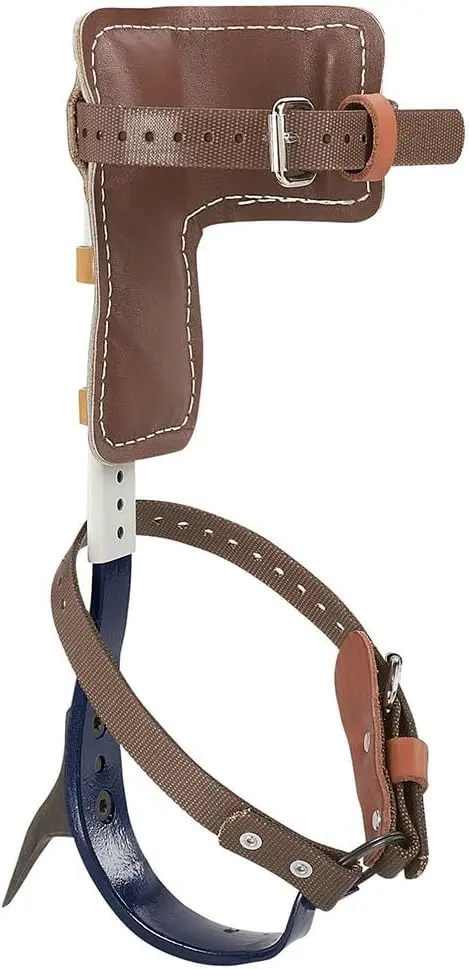
Klein Tools offers another robust steel climber option, the CN1907ARL, favored for its toughness in professional settings. These feature contoured leg irons, wide stirrups for foot support, and replaceable 2-3/4″ tree gaffs. The adjustable length (17″ to 21″) accommodates various users, and the cushioned leather pads provide comfort during use.
Similar to other steel models, they offer excellent durability suitable for daily professional use in tree removal and pruning. The replaceable gaff system allows for versatility if switching to pole gaffs is needed. They are a reliable choice known for solid construction and performance in demanding conditions.
While still relatively heavy due to the steel construction, they provide a dependable and long-lasting tool for arborists who value strength and resilience. Regular gaff maintenance is necessary for optimal performance and safety.
PROS
- Durable steel leg iron construction
- Comfortable cushioned leather pads
- Secure grip with 2-3/4″ tree gaffs
- Adjustable length (17″-21″) fits most legs
- Wide stirrups offer good foot support
CONS
- Heavy compared to lighter materials
- Gaffs require regular sharpening
- Initial pad stiffness during break-in
- Straps may stretch or loosen slightly over time
- Higher cost than non-professional models
Klein Steel Pole Climbers | Benchmark steel climber for utility line work durability
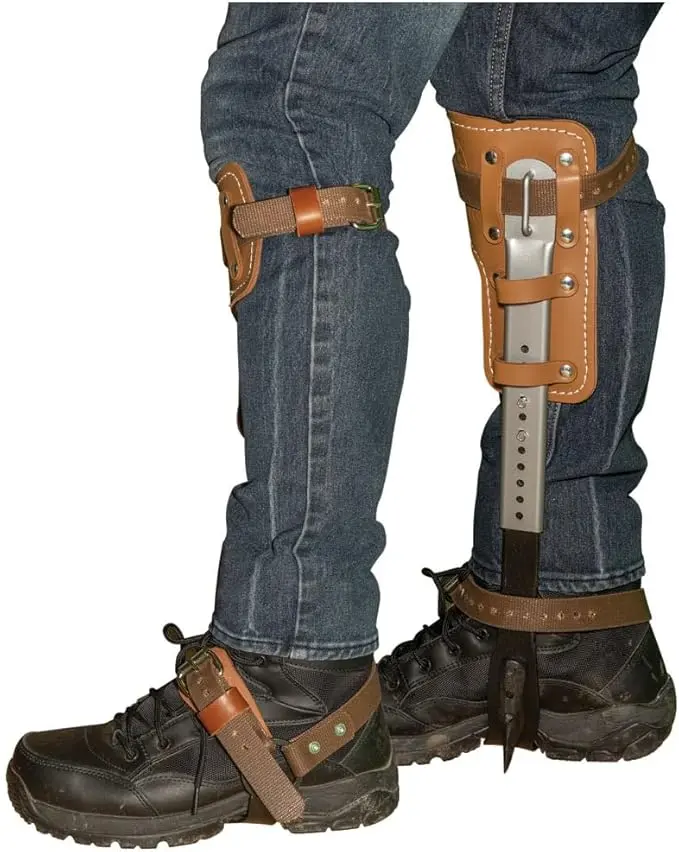
Specifically designed for utility line work, the Klein CN1972ARL pole climbers feature shorter, more acutely angled 1-1/2″ C.C.A. gaffs optimized for penetrating hard, treated utility poles. They share the durable steel construction, adjustable length (17″ to 21″), cushioned leather pads, and wide stirrups found on Klein’s tree climbers, ensuring reliability for linemen.
These climbers are the benchmark for many utility professionals due to their ruggedness and effective pole penetration. While primarily designed for poles, the gaffs are replaceable, allowing arborists who occasionally work on poles to potentially swap gaff types if needed, though they are less ideal for thick-barked trees than dedicated tree gaffs.
The main drawbacks are the weight inherent in steel construction and potential discomfort from the calf strap area if not adequately padded for some users. However, for dedicated pole climbing, their durability and specific gaff design are significant advantages.
PROS
- Durable steel leg iron construction
- Comfortable cushioned leather pads
- Secure grip with 2-3/4″ tree gaffs
- Adjustable length (17″-21″) fits most legs
- Wide stirrups offer good foot support
CONS
- Heavy compared to lighter materials
- Gaffs require regular sharpening
- Initial pad stiffness during break-in
- Straps may stretch or loosen slightly over time
- Higher cost than non-professional models
Notch Gecko Carbon Fiber 2.0 Climbers | Ultra-lightweight carbon fiber for maximum fatigue reduction
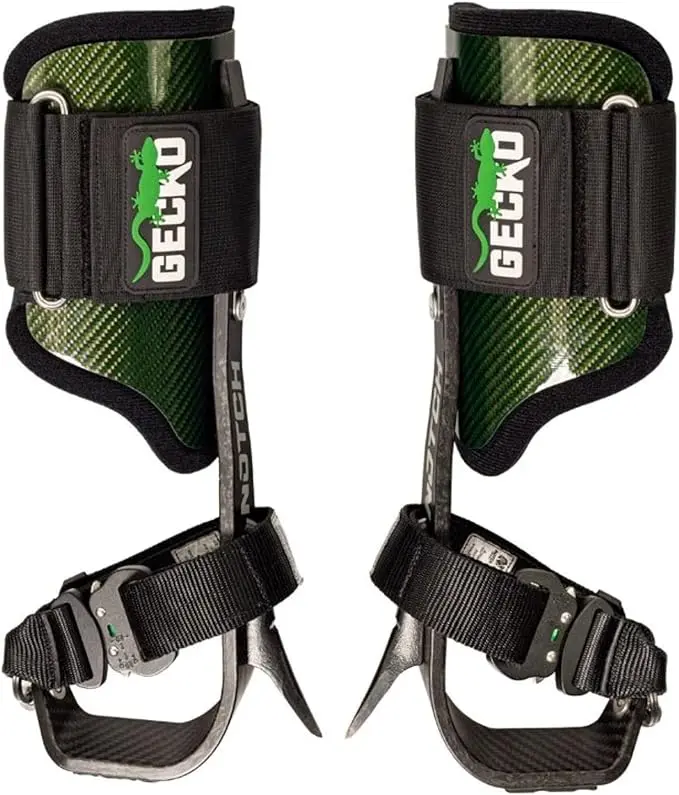
Representing the premium end for weight savings, the Notch Gecko Carbon Fiber 2.0 climbers significantly reduce fatigue during long days aloft. Their thermo-molded carbon fiber shanks provide rigidity at a minimal weight (around 4.7 lbs per pair). They come equipped with both 2-1/2″ tree gaffs and 1.86″ pole gaffs, offering excellent versatility for professionals working on varied structures.
Comfort is enhanced by anatomically formed fiberglass cuffs with high-density EVA padding and wide Velcro upper straps, distributing pressure evenly. Quick-connect lower straps and adjustable height (14.75” to 19.6”) ensure a secure fit. The offset leg stirrups and rubber sole plate aid stability and traction.
The main barrier is the high cost associated with carbon fiber construction. While extremely lightweight and comfortable, the material may be less forgiving of sharp impacts than metal, and the Velcro straps can show wear over time. They are an excellent choice for professionals prioritizing fatigue reduction and versatility, provided the budget allows.
PROS
- Ultra-lightweight (4.7 lbs) significantly reduces fatigue
- Strong and rigid carbon fiber construction
- Comfortable cuff system with EVA padding and wide straps
- Highly adjustable height range
- Includes both tree and pole gaffs for versatility
CONS
- Very high price point
- Velcro straps may wear or fray over time
- Gaffs require regular sharpening
- Quick-connect lower straps might loosen slightly
- Carbon fiber may be less impact-resistant than metal
Notch Gecko Aluminum 2.0 Climbers | Good balance of light weight, comfort (cuff system), and cost
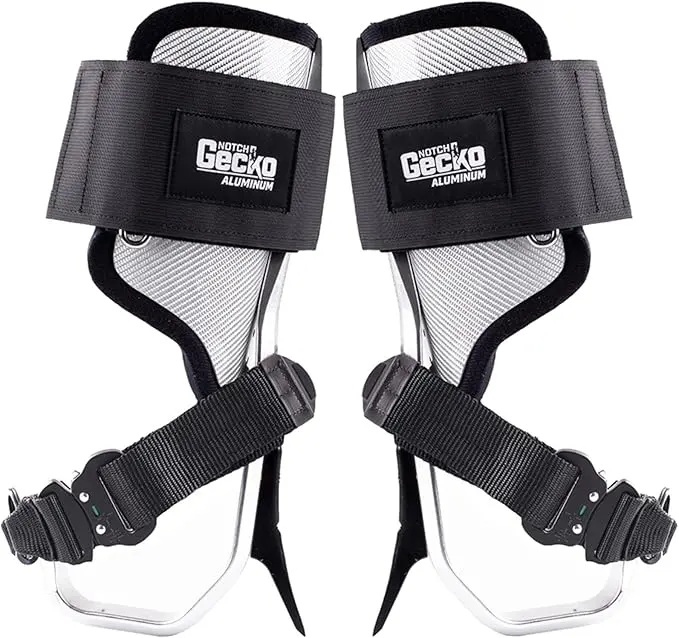
The Notch Gecko Aluminum 2.0 climbers strike a compelling balance between weight, comfort, and price. Using forged aluminum shanks, they weigh significantly less than steel models (around 5.3 lbs per pair) while remaining durable for professional use. They feature the same comfortable cuff system as the Carbon Fiber model, with reinforced fiberglass, EVA padding, and wide Velcro straps.
Equipped with 2.5″ replaceable steel tree gaffs (pole gaffs available separately), they offer secure grip for tree work. The adjustable height (14.75” to 21”) and offset stirrup design contribute to a stable and comfortable climbing experience. This model provides many benefits of the premium carbon fiber version at a more accessible price point.
Potential downsides include the Velcro straps wearing over time and the need for regular gaff sharpening, common to most spurs. They represent a strong value proposition for arborists seeking lightweight comfort without the top-tier cost of carbon fiber. How often do you find yourself needing to sharpen your gaffs?
PROS
- Lightweight aluminum construction (5.3 lbs) reduces fatigue
- Durable forged aluminum shanks
- Ergonomic cuff system enhances comfort
- Adjustable height fits a wide range of users
- Good value for a lightweight, comfortable climber
CONS
- Velcro straps can fray or wear out
- Gaffs require regular sharpening
- Quick Connect lower straps might loosen
- Heavier than carbon fiber models
- Velcro can be noisy (a concern for hunters using them)
Final Thoughts and Recommendations
Tree climbing spikes are highly specialized tools. They are indispensable for certain tasks like tree removal and utility pole climbing, providing efficiency and stability when used correctly by trained professionals. However, their use on live trees intended for preservation causes significant, lasting damage and goes against established arboricultural best practices (ANSI A300) and professional ethics. The wounds created offer entry points for pests and disease, disrupting the tree’s vital systems.
Professionals must select spurs based on their primary work, considering gaff type (pole vs. tree), material (steel for durability, aluminum/titanium/carbon fiber for weight savings), comfort features (pads, cuffs, straps), and budget. Regardless of the choice, adherence to safety standards (ANSI Z133, OSHA regulations), comprehensive training, use of associated PPE, and diligent equipment inspection and maintenance are absolutely non-negotiable.
For homeowners needing tree work, the recommendation is clear: hire qualified, insured arborists (e.g., ISA Certified) who demonstrably follow industry standards. Specifically inquire about their climbing methods for pruning live trees and insist on spikeless techniques to protect your valuable trees from unnecessary harm. A true professional prioritizes tree health alongside safety and efficiency.
Key Action Items:
- Professionals: Stay current with ANSI and OSHA standards. Invest in regular training refreshers and meticulously maintain all climbing equipment, especially gaff sharpness and strap integrity. Choose the right tool for the job – spikes for removals/poles, spikeless for live tree care.
- Homeowners: Verify arborist credentials (ISA certification, insurance). Ask directly about their methods for pruning live trees. Choose professionals committed to spikeless climbing techniques for preserving tree health.
Frequently Asked Questions
Can I use tree climbing spikes for pruning my trees? >
What is the main difference between pole gaffs and tree gaffs? >
How often should I sharpen my climbing gaffs? >
Are expensive carbon fiber spurs worth the cost? >
We are a participant in the Amazon Services LLC Associates Program, an affiliate advertising program designed to provide a means for sites to earn advertising fees by advertising and linking to Amazon.com. As an Amazon Associate I earn from qualifying purchases. We also participate in other affiliate programs. The information provided on this website is provided for entertainment purposes only. We make no representations or warranties of any kind, expressed or implied, about the completeness, accuracy, adequacy, legality, usefulness, reliability, suitability, or availability of the information, or about anything else. Any reliance you place on the information is therefore strictly at your own risk. Additional terms are found in the terms of service.



